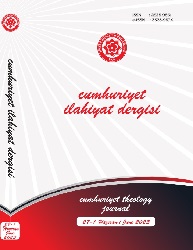Memlûk Devleti’nin Oluşum Yıllarında İktidarın Kaynağı: Sultanın Otokrasisi mi Ümeranın Oligarşisi mi?
The Source of Power in the Formative Years of the Mamluk State: Autocracy of the Sultan or Oligarchy of Amīrs?
Author(s): Yusuf ÖtenkayaSubject(s): Political history, Government/Political systems, Studies in violence and power, 13th to 14th Centuries, 15th Century, 16th Century
Published by: Cumhuriyet Üniversitesi İlahyat Fakültesi
Keywords: Medieval History; Mamlūks; Power; Autocracy; Oligarchy;
Summary/Abstract: There are many studies and theories in the literature on the source of power in the formative years of the Mamlūk state. In these studies, the importance of power and influence as a form of becoming a sultan in the Mamlūks has been emphasized, although the oligarchic power of the umara has been indirectly mentioned in terms of the source of power by discussing the distinction between a puppet sultan and an authoritarian sultan. However, this axiom causes a number of problems and ambiguities within itself and leads to the supersession of the determinism of the elite amirs. This work will try to overcome this problem by focusing on the political developments during the foundation years of the state and discussing how powerful and influential amirs were restricted by the umara on their way to becoming sultans. At the same time, by focusing on the chronicles of the period in question, the administrative determinism of the Mamlūk factions as a decision-making mechanism in the Mamlūk state will be pointed out. On the other hand, the statement that power emanated from both the sultan’s household faction and the military support of the elite amirs or khushdāshs who held the Mamlūk oligarchy in their hands leads to overlooking the tension or conflict between the two throughout Mamlūk political history. Considering the state of conflict between the two sides, it is a logical contradiction for the two opposing poles to agree on the same candidate. For instance, considering Muʿizz Aybak’s accession to power, the Sālihiyya-Bahriyya amirs unanimously endorsed his sultanate, but in the process, Muʿizz Aybak prevailed over the tensions he experienced with the elite that brought him to power and managed to become the absolute sultan, albeit for a short time. Therefore, it is essential to keep in mind that there was no uniform relationship between the sultan and the elite amirs, but rather a dynamic functioning. In other words, the future sultan, who had to establish good relations with the amirs until he became sultan, had to go against the amirs who brought him to power if he wanted to become an absolute ruler after he became sultan. In this study, the source of Mamlūk power is traced to the collective interests of the Mamlūk factions. It is emphasized that these interests were usually centered on candidates who were seen as more moderate among the factions. At the same time, by revealing the shortcomings of the understandings presented as a rule such as “the one who kills the sultan becomes the sultan” and “the powerful and influential become the sultan”, the analysis of the period from the founding years of the Mamlūks to Baybars’ sultanate mostly emphasizes the continuity of the status quo of the elite amirs by highlighting the “sultanate of weak and middle-ranking amirs”. The analysis has pointed out that those who killed sultans or usurped the throne were punished rather than usurping the throne as a legitimate right. Similarly, the consensus of the umara on the candidate for sultanate was pointed out by mentioning that those who were powerful and influential were being challenged rather than made sultan.
Journal: Cumhuriyet İlahiyat Dergisi
- Issue Year: 27/2023
- Issue No: 1
- Page Range: 234-248
- Page Count: 15
- Language: Turkish

